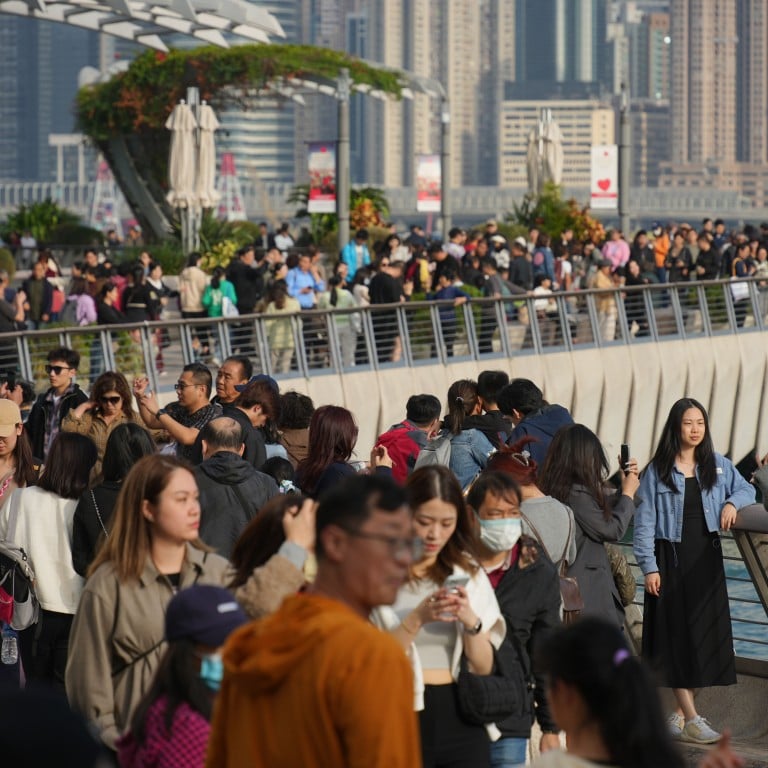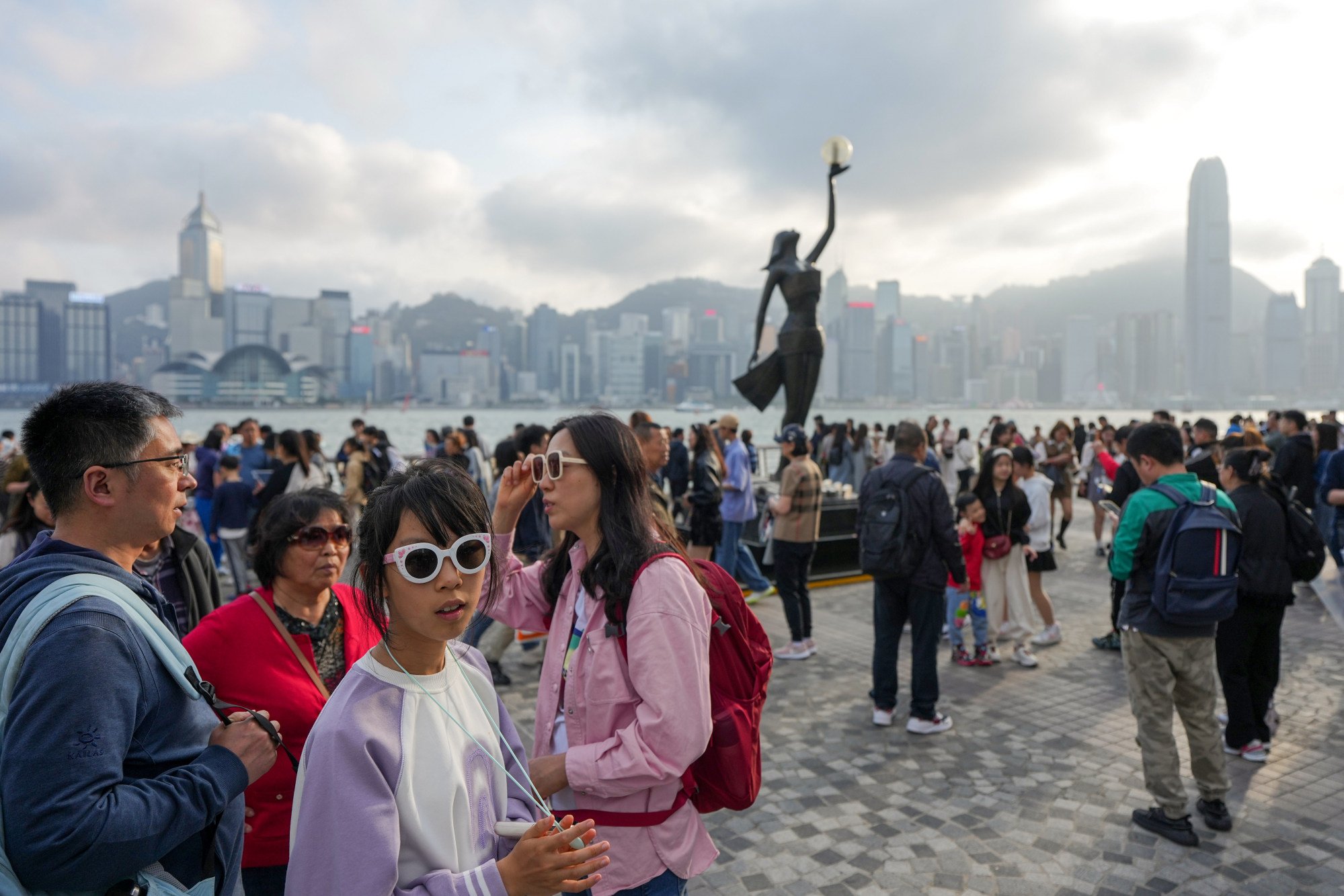
Hong Kong, mainland China authorities in talks to allow more visitors from tier 2 and 3 cities, top official says
- Chief Secretary Eric Chan says he hopes for tourism boost from more mainland visitors ‘as soon as possible’, although he stopped short of giving timeline
- Mainland authorities will take cautious approach in discussions to avoid repeat of past mistakes, political commentator Lau Siu-kai says
Hong Kong authorities are in talks with their mainland Chinese counterparts on expanding a travel scheme to allow more residents of second- and third-tier cities to visit, with the possibility of a multiple-entry arrangement, a top official has revealed.
No 2 official Eric Chan Kwok-ki said he hoped more visitors could visit Hong Kong from the mainland “as soon as possible” to help boost the tourism sector, although he stopped short of giving a timeline.
“We are … looking to expand the list of cities under the scheme and also exploring the possibility of multiple-entry endorsements,” the chief secretary told a radio programme.
But the government would have to liaise with authorities in different provinces and cities, which could “take some time”, he added.

Currently, residents from 49 mainland cities can travel to Hong Kong twice a year under the Individual Visit Scheme and stay up to seven days each time.
The scheme, introduced in 2003, accounted for 60 per cent of all mainland arrivals last year.
Starting in 2009, Shenzhen residents were also allowed to apply for “multiple-entry” Individual Visit Endorsements, which enabled holders to freely enter Hong Kong within a one-year validity period.
Hong Kong airport ranks fourth for passenger traffic in Asia-Pacific region
Lau Siu-kai, a consultant for Beijing’s semi-official think tank, the Chinese Association of Hong Kong and Macau Studies, said the mainland would take a cautious approach in discussions to avoid a repeat of past mistakes.
Lau said there was a time when mainland tourists visited Hong Kong in droves and many took advantage of the city’s public resources, which resulted friction with locals.
“This led to the rise of localism and talks of independence in Hong Kong, which harmed relations between the city and the mainland, and damaged Hongkongers’ impressions of Chinese authorities,” he said.

Chinese authorities were also aware that many Hongkongers spent a lot of time over the border but not many mainlanders were going to the city, he added.
“Tourism can help create job opportunities, especially for low-earning groups in Hong Kong,” he said. “It can also improve Hongkongers’ confidence in the economy, revitalise the city and stabilise the political situation.
“Mainland authorities might take a step-by-step approach to test the waters and observe whether people are pouring into Hong Kong and what kind of effect this would have on people’s daily lives.
“Would places for daily supplies or groceries be replaced by pharmacies or herbal medicine stores? We can’t say yet as we need to consider the whole picture.”
Hong Kong tourism numbers forecast to return to pre-Covid level by end-2025
Lawmaker Holden Chow Ho-ding said he was not worried that parallel trading would undergo a resurgence even if more mainland tourists were allowed to visit.
Parallel traders buy goods in Hong Kong and then resell it on the other side of the border at a profit to evade hefty mainland import and value-added taxes. Popular products include cosmetics and medication.
“The consumption pattern has changed,” Chow said. “Daily necessities can be bought online or through other channels. There is no need for parallel trading and not much money can be made from it any more.
Hong Kong’s star shines as Greater Bay Area’s rich tap tax breaks, incentives
“If we talk about residents in cities that cannot travel to Hong Kong yet, it is unlikely they will be coming by road,” he added. “They will be visiting via the high-speed rail or plane, which is very different to Shenzhen visitors who go back and forth everyday.”
Chief Secretary Chan also said the extended checkpoint operating hours were not feasible on a daily basis, despite the number of visitors returning to pre-pandemic levels.
“We added the round-the-clock border control [over the Lunar New Year period], but we cannot do this every day,” he told the programme. “It will depend on our actual needs. If the demand is weak, it’d be a waste of resources. We have to be very precise.”
After thousands of mainland tourists were left stranded at the border following New Year’s Eve celebrations on January 1, Chan held discussions with mainland authorities on extending operating hours at checkpoints connected by railway services and increasing the number of 24-hour border crossings for the Lunar New Year period.
Driving tourism is as simple as focusing on Hong Kong’s unique appeal
The Shenzhen Bay checkpoint, connecting the western areas of Hong Kong and Shenzhen, operated 24 hours a day over a five-day period from Lunar New Year’s Eve on February 9 to February 13. The checkpoint usually operates between 6.30am and midnight.
Hong Kong has 14 control points and four operate around the clock – those at the airport, Lok Ma Chau, the Macau Ferry Terminal in Sheung Wan and the Hong Kong-Zhuhai-Macau Bridge.
“There are fewer people passing through the borders at night,” Chan said. “We’d encourage visitors to stay in Hong Kong if they’re here until 3am or 4am. We don’t have enough manpower and they might have a long wait.”
Hong Kong tourism blueprint ‘won’t be ready until second half of year’
Over the Lunar New Year period of February 10 to 13, the numbers of inbound and outbound visitors returned to pre-pandemic levels and operations were smooth, according to Chan.
He said that before the pandemic visitors stayed 3.1 nights on average, and the figure rose slightly to 3.4 in the fourth quarter of 2023.
In the years before the pandemic emerged, about 40 per cent of mainland visitors would stay overnight in Hong Kong, and that number had increased to 46 per cent last year.
The city welcomed nearly 4 million visitors in December, three-quarters of whom were from the mainland, according to Hong Kong Tourism Board statistics.
It marked an increase from 160,578 in December 2022 when the city’s pandemic restrictions were still in place, with 67,244 of them from the mainland.

